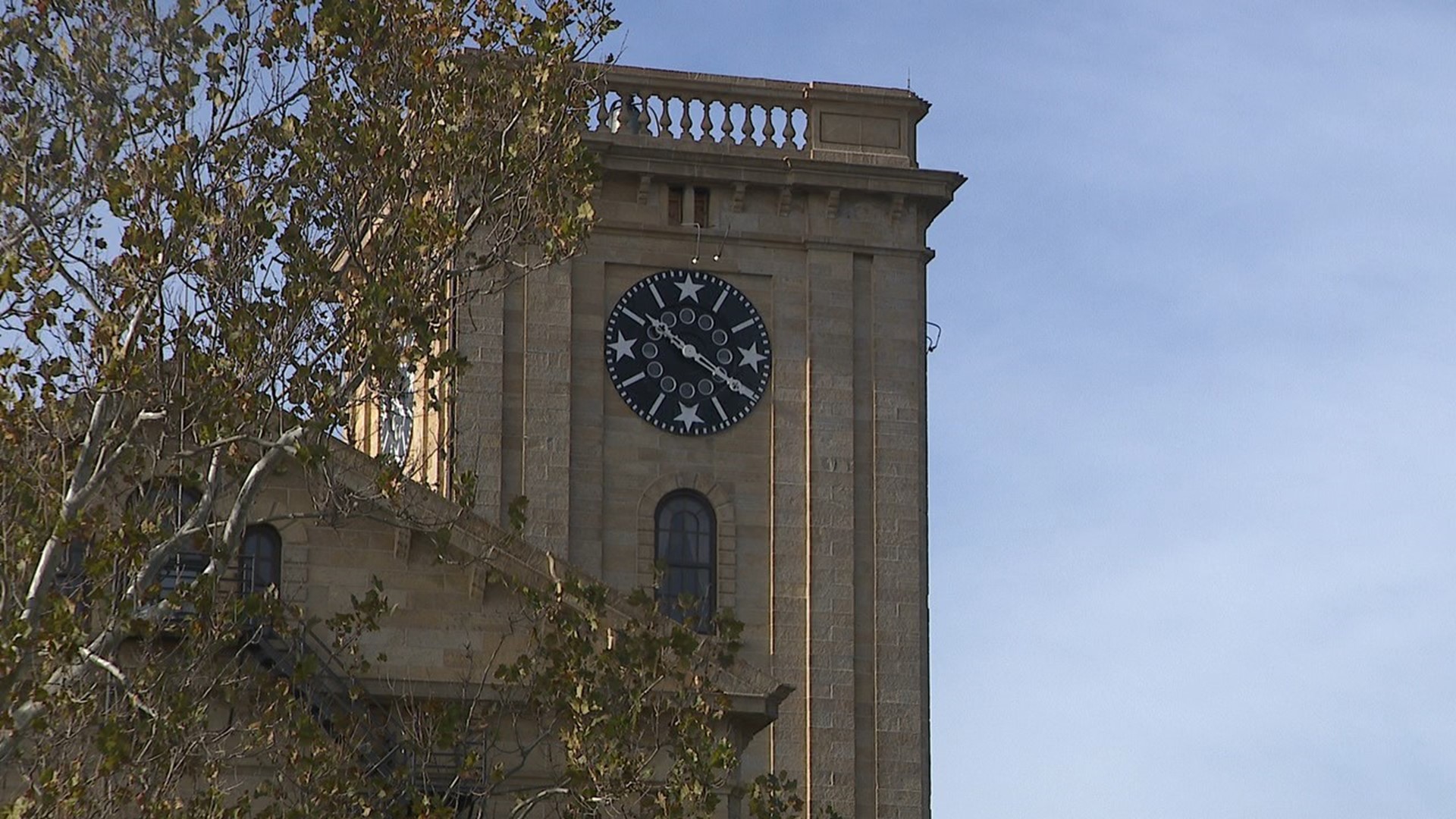ROCK ISLAND ARSENAL, Ill. — On Sunday morning, we'll turn back the clocks at 2 a.m. for the end of Daylight Saving Time. These days, it seems like most clocks are digital and adjust their times automatically, but there are still some that need to be manually adjusted.
For example, the historic clock tower on the Rock Island Arsenal. The building the clock is housed in belongs to the U.S. Army Corps of Engineers. The clock was designed and built in 1867 and began telling time in 1868. It's up on the sixth floor of the building with a 32-foot pendulum that descends down the lower two stories. There are four 12-foot wooden clock faces, each with 12 round glass windows at the hour points.
Every Thursday, Jake Kraft is in charge of winding the clock weights and the bell weights. It used to be wound completely by hand, but in the 1950s, it was switched to an electric motor.
"We take them all the way up, so as they slowly fall down, it drives the clock mechanism," Kraft said.
As the clock winder, he'll turn the clock back one hour this weekend.
"I'll actually spin this clock forward 11 hours instead of going backwards because it's hard to go back," Kraft said.
Just don't expect that to be done at 2 a.m. on Sunday.
"Probably be here about 10:00," he said. "As long as it's done before the colonel or anybody important gets here on Monday morning, I'm good."
Meanwhile, over in Moline, Josh Whiting has his own clocks he's in charge of. He's a traffic operations specialist.
One of those is the C.I. Josephson Jewelers clock. The 18-foot tall clock stood in front of the Josephson's jewelry store at 1514 Fifth Ave. from 1912 to 1984. It later moved with the business across from South Park Mall. It was donated to the city of Moline in 2002 and after extensive restoration, the clock was returned to Fifth Avenue a year later.
"The first time I opened that I had no clue what I was looking at," Whiting said. "It took the guy from Florida to come back up here to instruct me on how to change the time."
When he opens it up, you can see the pendulum and another smaller clock.
At one point there was an idea to digitize it. Whiting said it was having issues where it was shutting off every other day. He was able to figure out there was an issue with the heater keeping the motor warm during the winter months.
"It's run well now," he said. "We're glad that we have kept it to the historic significance."
He's also in charge of some clocks you might not even know about. The city maintains 105 cabinets that control traffic lights at intersections. Whiting has to make sure the clocks stay synced within the specific traffic corridors. There are a few that aren't connected to the signal so Whiting has to make sure those are synced manually.
Those corridors depend on having the correct time.
"It's based on your traffic patterns," Whiting said. "The cycle lengths vary throughout the day. Sometimes you might need a 90-second cycle."
The traffic boxes have a digital mechanism and will automatically adjust to the beginning and end of Daylight Saving Time, much like a smartwatch or phone does.
"Smartwatches have definitely taken a toll on the watch industry in general," Will Doland, the owner of Doland Jewelers, said.
He carries fewer watches than he used to but still sees a purpose for them. The store focuses on carrying watches that match a style people in the Midwest gravitate towards. Doland said that tends to be more of a simple, clean watch.
"Many people will still purchase watches for gifts for first jobs, things like that," he said. "There's still a professionalism to wearing a watch. There's still a dress to wearing a watch. It's still a status symbol and mainly used for fashion more than anything anymore."
Over in Davenport, Randy Epkes is surrounded by clocks all day. He runs Epkes Clock Repair. He learned the trade from his dad, so he's been repairing clocks for 40 years now.
"I just like the mechanics of it, especially the older clocks, because each clockmaker engineered their movements in their own way," Epkes said. "They follow the same basic theme, but it's interesting how they've engineered each movement just a little bit different."
Many of the clocks are antique, family heirlooms, one as old as 250 years old. To him, an old clock has sentimental value.
"The tick-tocking of these clocks is kind of comforting to some people, you know, you don't get that with the digital clocks," Epkes said. "A lot of the people will tell me that they remember these clocks growing up as a child, and so to keep them running in their own homes is comforting."
Whether Daylight Saving Time ever becomes permanent, like some lawmakers have pushed for, there's still a lot of interesting history behind what we use to tell time.

